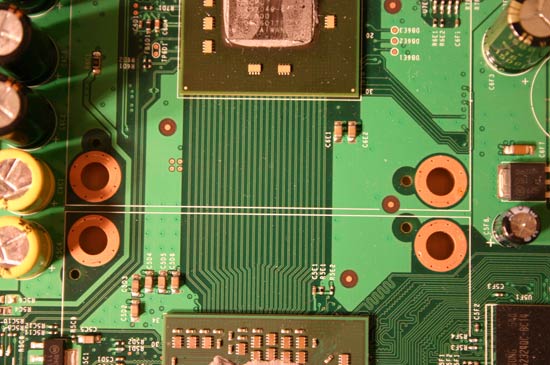Inside Microsoft's Xbox 360 - A Tour of the 360's Motherboard
by Anand Lal Shimpi on November 18, 2005 12:19 AM EST- Posted in
- Systems
Final Words, and a Refresher on the Benefits of Serial Buses
We hope you enjoyed this brief tour of the Xbox 360's motherboard, being the last weekend before Microsoft's official retail launch, we figured it would be a good send-off.
We'll actually end this tour of the 360's motherboard with a little comparison point in the advancement of bus technologies. For the past several years, the PC industry has seen a transition away from older parallel bus interfaces (IDE, Parallel Ports, traditional FSBs, PCI/AGP) to much faster serial buses (SATA, USB, Hyper Transport, PCI Express). The Xbox 360's motherboard actually gives us an opportunity to present a good comparison of the benefits of a serial interface, from a layout perspective.
The link between the Xenon CPU and the Xenos GPU in the Xbox 360 is actually two 10.8GB/s serial buses, which you can clearly see from the picture below. Note the clear definition of the traces the clean routing, to the point where you can count the individual data, address and clock lines:

This is similar to the type of routing you'd see connecting two Hyper Transport ports on an AMD motherboard.
Now let's take a look at the parallel GDDR3 interface between the ATI GPU and the Samsung GDDR3 memory:

Note the significant increase in traces, attributed to a much wider parallel interface than what exists between the CPU and GPU. The more complex routing of parallel buses becomes an even bigger problem as devices demand more bandwidth, which is why we have seen such a large scale transition to serial interfaces.










27 Comments
View All Comments
Calin - Friday, November 18, 2005 - link
I don't think you can modify it now to run Linux - at least not to run Linux well. The hardware inside doesn't have yet drivers in Linux (while the CPU could be supported right now by Linux, the video probably isn't. The others probably are, but might not identify themselves as the parts they (just like the chips are engraved with Microsoft XBox 360 no matter who produce them)Alphafox78 - Friday, November 18, 2005 - link
Its way too early for that, the DRM has to be cracked first so uncoded apps can be usedPhantronius - Friday, November 18, 2005 - link
You would think Anandtech had never seen a console before judging from the way they rip into them like a 5 year old.ksherman - Friday, November 18, 2005 - link
YOU HAVE A YONAH PROCESSOR!?!?!?! is it any good? i guess it would likely be under an NDA...Great article! too bad i cant afford one of these puppies for a while... happy with my BF2 fragging machine for now!
fuzzynavel - Friday, November 18, 2005 - link
Nice pair of 360 articles....but have you actually played the damn thing yet!!!!finbarqs - Friday, November 18, 2005 - link
Yes, playing the game, are ANY games 60 FPS? 30 FPS is the previous gen, we're moving to a new era where all games needs to be 60fps... Namely Bizarre, who keeps saying that their PGr3 game will run at 60 fps... But been so quiet since they said it.. In fact, no one mentions it... Bizarre probably has a NDA on that because people will not buy the game because it didn't hit 60fps.Calin - Friday, November 18, 2005 - link
Yes, I was wondering about that too...mrgq912 - Friday, November 18, 2005 - link
I always thought those lines on the motherboards were a design element. Who ever knew it actually carried data.Learn something new on anand everyday. got a love it.
Zirconium - Friday, November 18, 2005 - link
All kidding aside, it is interesting to see the ways the board designers try to make all the traces the same length from the GPU to the memory. It also shows that the technology is so fast, that slight differences in the amount of time it takes the signal to travel can cause errors.Googer - Friday, November 18, 2005 - link
They are just like physical copper wires and those lines are not there for beauty either. Some lines carry data and others transmit the various levels of power (voltage) needed to run the components. These are the lines that keep every thing on and connected to each other.